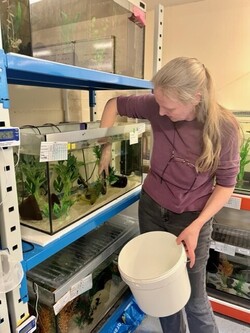Bettina Fischer, Research Assistant
What is your current role?
I am a Research Assistant with the Durbin Group.
When did you start with the department?
I started at the department in 2003, working as the Flychip Microarray Service Facility lab manager for Steve Russell. Back then, people could send us Drosophila tissue. We extracted RNA, labelled and hybridized the samples to arrays, and processed the data. Moreover, I was optimising gene expression and ChIP-array protocols, assessing analysis software, as well as writing and adapting analysis scripts and pipelines.
How did you get started in science?
I always knew I wanted to do something in the field of Biology. At university, I struggled with Maths and Physics. When trying to figure out which areas to work in, animal research was out of the question due to my allergies. I thought about environmental biology, but this was too niche. In the end, I chose to work as a chemical technician which covered a large variety of tasks.
My first job was in a medical lab. I worked there for 4 years. It was a great start, but wasn’t the field I wanted to specialise in. I moved on to a DNA sequencing facility in Cologne. The job was very labour-intensive since I had to manually load the gels, and also involved staying on top of a large amount of data. Moreover, I gained experience working in different lab environments. I eventually moved to the UK and started working at the University of Dundee. My responsibilities included genotyping of diabetes patients and children attending primary school, looking into nutrition and obesity risks.
In 2003, I joined Steve Russell’s group here at Cambridge University. I started to work for Richard Durbin in 2019. During my time in Cambridge, I have also been a part of collaborations with Sarah Bray and Rob White at the Department of Physiology, Development and Neuroscience.
What are you currently working on?
I am currently working on Nanopore sequencing which was a field entirely new to me when I started out. I trialled protocols for high-molecular-weight DNA of cichlids. This not only benefits the Durbin lab but also other people in the department. I am assisting them with the library preparations, and also set up the flow cells. During the pandemic, I mainly focussed on projects involving bioinformatics. Now, with everyone back on site, it’s lab work again.
Currently, we are working on two projects. One centres around creating a hybrid cross of Maylanida zebra and M. pearly to investigate bar pattern formation. The other one involves knocking out genes that might regulate bar pattern formation through embryo microinjection.
What was a defining moment in your career?
Doing bioinformatics! I got into it while working at FlyChip. Because we needed someone to write code to process the data, I decided to learn programming. I sort of surprised myself a bit there, considering my lifelong struggle with maths. I familiarised myself with Pearl and then moved on to R. Shows that, sometimes, you just need to jump in and have a go.
What advice would you give to other women wanting a career in science?
Take a chance and get out of your comfort zone! Don’t think “I can’t”. Think “I can!”
What are your future goals?
I hope I can continue to work at Cambridge University. I like our Genetics department and the people who work here. It’s a great place to do research.
Fun Fact
One of my hobbies is crocheting. Recently, I started crocheting cichlids.

